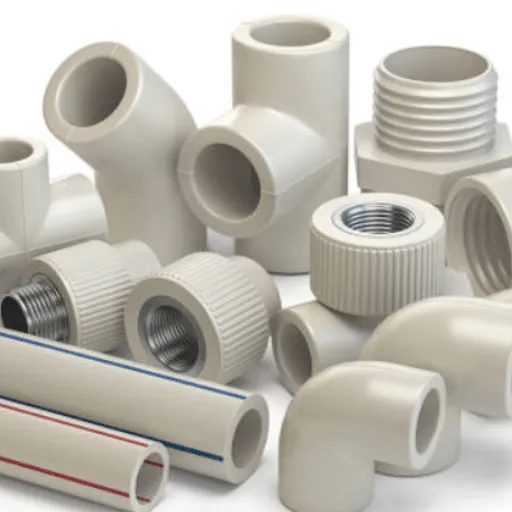Polypropylene fitting is a boon to modern piping systems, given their versatility, durability, and efficiency. These innovative fittings can find applications in household plumbing, industrial processes, or agricultural systems, presenting an apt solution to fulfill different requirements. This article discusses the special characteristics of polypropylene pipe fittings and their multiple advantages over conventional materials, and the various fields in which they help. You are right to look here if you’re interested in developing a deeper appreciation of why polypropylene came to be a leading choice in engineering and construction projects.
Introduction to Polypropylene Pipe Fittings
What are Polypropylene Pipe Fittings?
Polypropylene pipe fittings are components made out of polypropylene, which belong to the thermoplastic polymer family and are widely acknowledged for their strength, chemical resistance, and versatility. These fittings can join either two or more pipes or even redirect or stop their flow for use elsewhere in the piping systems of different industries. Being lightweight and strong, they make it easy to manage the movements of fluids and gases.
The major advantage of polypropylene pipe fittings is that they are good at resisting corrosion, scaling, and chemical attacks. Unlike their metallic counterparts, they cannot rust; therefore, they can remain in standing waters containing varied concentrations of acids, alkalis, and solvents. This ensures longevity whenever there exists a high requirement for chemical compatibility, i.e., chemical processing, polishing, water treatment, and industrial applications.
Furthermore, polypropylene fittings are appreciated because of their simplicity in construction and economy. These pipe fitting methods normally make heat or electrofusion joining, which otherwise would not secure leak-proof connecting and entail costly tools and labor from joining processes. Due to this, polypropylene pipe fittings have found their way as a solution to traditional plumbing and industrial engineering projects.
Benefits of Using Polypropylene Pipe Fittings
- Chemical Resistance: One of the features of polypropylene pipe fittings is that they resist almost all kinds of chemicals, including acids, bases, and organic solvents. Hence, they are used in chemical processing and industrial environments where corrosive substances are usually attacked.
- High Thermal Tolerance: Able to endure temperatures from -20°C (-4°F) up to approximately 95°C (203°F), polypropylene fittings are suited for hot and cold water applications. This thermal endurance reduces the possibility that the material will deteriorate in variable temperature conditions.
- Light in Weight and Tough in Design: Polypropylene fittings are comparatively lighter than their metal counterparts, easing the transportation and installation processes while offering strength and durability. Also, they show good mechanical properties and ensure good service life even at their lightweight.
- Environmentally Sustainable: In case of recycling needs, polypropylene is a recyclable material, and it makes these fittings an environmentally friendly choice. Also, the production of polypropylene fittings requires less energy when compared to metal ones; thus, contributing to lower carbon emissions.
- Cost-Efficiency: The greatest cost-efficiency is that polypropylene fittings cost less to buy and maintain. They resonated with long life, thereby requiring few replacements; and joining techniques hooked on fusion are engaged to keep labor and equipment costs down, hence saving in the long run.
Common Applications of Polypropylene Pipe Fittings
Polypropylene pipe fittings find application in numerous industries because of their potential, durability, and cost-effectiveness. Here are five applications with explanations:
Water Systems
Polypropylene fittings find widespread applications in water systems-at residential, commercial, and industrial levels. They resist corrosion, chemical leaching, and high temperatures and thus can be used for conveyance of both hot and cold water. It has been shown that the lifecycle of polypropylene piping used in plumbing systems lasts for more than 50 years under normal operating conditions.
Chemical Processing Industries
Withstanding all types of chemicals, corrosive acids, and viscous alkalis in processing plants give a white-glove service to the fittings. This material does not suffer in maintenance as it passes the test of time against reactive media. Example: Acting against solutions having pH ranging from 1 to 14, polypropylene stands unchallenged.
Irrigation Systems
In agricultural irrigation, fittings give dependable service, resisting UV degradation and other variable outdoor conditions. These are employed in drip irrigation, sprinkler systems, and long-distance water conveyance to boost agricultural output and cut down on water losses.
HVAC Systems
Polypropylene pipe fittings are an important element of heating, ventilation, and air conditioning systems. They are used to convey chilled and hot water in association with HVAC equipment. Their thermal insulation properties and low thermal conductivity result in an energy-efficient system.
Industrial Drainage Systems
These fittings are used for industrial waste drainage owing to their resistance against abrasion and chemical-laden wastes. Their non-reactivity and leak-proof nature provide for the safe disposal of wastes, liquids under varying pressures, and temperatures.
By these applications, the huge potential offered by polypropylene pipe fittings is evident, making them indispensable in modern infrastructure and industrial processes.
Types of Polypropylene Fittings
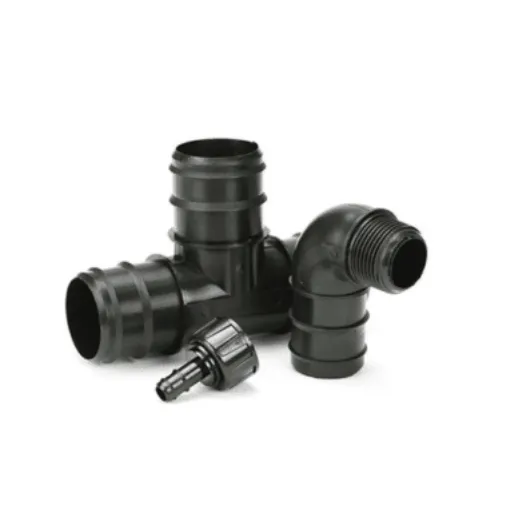
Elbows: Configurations and Uses
Polypropylene elbow fittings are employed in piping systems to manage space constraints and directional changes, usually 45 or 90 degrees. These fittings help optimize fluid or gas flow while preserving efficiency and minimizing pressure drop. In systems that may, for space constraints, require very precise angular directions or that may impose complex layouts necessitating several routing options, these fittings prove highly appreciated.
With the advancement of technology, polypropylene elbows continue to be tailor-made to withstand a plethora of conditions. For instance, it resists deformation under high pressures and temperature extremes, thereby ensuring reliability in chemical processing or wastewater management. Resistance to scaling and corrosion extends the life of such pipes, thereby lessening maintenance and replacement costs. They are socket-welded, threaded, and electro-fusion cases; thus, these elbows meet every simple or complicated need.
The employment of polypropylene elbows for smooth transition inside the pipe not only preserves the structural integrity of the system but also keeps up the efficiency of the system, making it an indispensable element in modern piping solutions.
Tees: When to Use Them
Tees are critical components of piping systems, designed to either combine or split the flow of fluids, gases, or slurries in the infrastructure. These fittings are manufactured in the “T” shape, with one inlet and two outlets set at 90-degree angles to the main run. They come in handy when you have to branch off and change the flow direction without endangering the system’s efficiency.
The two main types of tees used in piping systems are equal and reducing. An equal tee comes into use when it is important to maintain equal diameter in all three connections, thus keeping the flow uniform across the system. In contrast, a reducing tee is supposed to control flow size by connecting a branch with a large pipe diameter to smaller diameter outlets, a feature of utmost importance for applications where flow and pressure control are required.
In accordance with present-day standards of manufacturing, tees are made from resistant materials such as polypropylene or stainless steel, of the highest grades, in order to assure durability, corrosion resistance, and high tolerance for stresses of extreme temperature or pressure. On top of that, tees may be provided with socket-weld, threaded, or butt-weld ends to suit different requirements of application. When used correctly in pipeline designs, tees can be a very potent tool for engineers in engineering effective fluid dynamics, keeping operational efficiency over long periods of time, and attaining high levels of performance in both simple and complex designs.
Couplings and Reducers: Options for Connection
Couplings and reducers are vital components in pipeline systems, maintaining a link between two pipes or allowing for a smooth transition between pipes of different diameters, materials, or configurations. Couplings chiefly connect two sections of pipe, either permanently or temporarily, and they come in many forms-can be rigid, flexible, compression type, or any other type acceptable to the system. They are designed to hold the system together and stay waterproof, even when subjected to high pressure or temperatures.
Reducers, primarily for allowing smooth diameter transitions at points in the pipeline and good flow rates in the system, come in two main configurations-depending on whether or not the smaller end axis is aligned with the larger end. The basic criterion for selection is the alignment of the axis with that of the pipeline, or some consideration relative to gravity or flow. For instance, concentric reducers are to be used in installations where a centerline connection is necessary, while eccentric ones are for preventing the formation of air pockets or to assure even draining.
Employing advanced manufacturing procedures with the strongest materials-such as stainless steel, carbon steel, or more advanced alloys-ensures that these components satisfy the highest standards of the industry, such as ASME or ASTM. Such as fluid-type, operating conditions, and code compliance are critical in deciding on types of couplings and reducers. Precision couplings and reducers allow the engineer an enhanced scope for the reliability, efficiency, and expansion of a piping system, be it for chemicals, petrochemicals, or water treatment.
Installation Techniques for Polypropylene Pipe Fittings
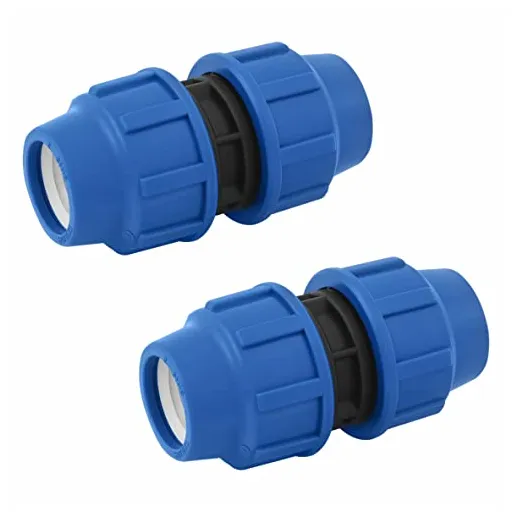
Step-by-Step Installation Guide
-
1Tools and Materials Preparation: Ensure the availability of all tools and materials required, including pipe fittings of polypropylene, pipe cutter, chamfering tool, cleaning agent, and correct joining equipment, such as fusion welding machines or threaded connectors. Verify that the fittings meet the relevant standard (e.g., ASTM D4101 for polypropylene materials) for compatibility and safety.
-
2Measuring and Cutting: Measure the pipe accurately and mark it with a marker at the cutting point. Use a special pipe cutter designed for polypropylene materials to cut the pipe to the desired length. Care should be taken to keep the cut clean and square; otherwise, an uneven cut may jeopardize the joint.
-
3Pipe End Preparation: Chamfer pipe ends using a chamfering tool. Beveling eases the assembly of fittings and minimizes the risk of damage during installation. Clean the pipe ends with a cleaning agent to clear dust, grease, or contaminants.
-
4Dry Fitting: Assemble the pipe and fitting without any adhesive or fusion processes to check for proper alignment and fit. Changes can be made at this stage before the permanent joint is accepted.
-
5Welding or Joining: Carry out the joining process according to the procedures described by the manufacturer for joining, which may include heat fusion or electrofusion. In heat fusion, pre-heat the machine to the specified temperature (usually 260-270°C for polypropylene), position the pipe and fitting in the fusion tool, and hold until a bond has been made. Strictly observe the cooling and handling times so as not to compromise the joints.
-
6Pressure Testing: After the piping system has been assembled, conduct a hydrostatic or pneumatic pressure test so as to verify that the joints are firm and that the system will leak no more. The pressure must be maintained within the range specified by the relevant industry standards, with the results recorded for compliance.
-
7Inspection and Final Adjustment: Examine thoroughly all the joints and alignment of the system. Make sure all fittings are installed securely with no traces of stress or misalignment. Adjustments should be made if necessary to achieve the best performance and longevity.
When these steps are adhered to, the installer will have a robust and reliable connection with which to work using polypropylene pipe fittings, hence limiting the potential of failure and increasing system longevity.
Common Mistakes to Avoid
- ❌ Poor Pipe-Cutting Practice:Typical mistakes in working with polypropylene pipe fittings occur during improper pipe cutting, while ragged or uneven edges would give way to improper fits and/or leaks. Make sure to always use a proper pipe cutter for that material and to keep the cut smooth and perpendicular.
- ❌ Poor Cleaning of Pipe Ends: Dirt, grease, or residue on pipe ends can seriously compromise connections. Be sure to give a thorough cleaning and preparation to the pipe surfaces so that the joint does not weaken and instead serves longer, so that the system will not fail prematurely.
- ❌ Over-Tightening of Fittings: Polypropylene fittings can crack from over-tightening, thereby compromising the system with unnecessary stress. Always follow the manufacturer’s torque specifications to avoid this problem and maintain system integrity.
- ❌ Neglecting Thermal Expansion: Polypropylene pipes tend to expand and contract due to temperature changes. Since one may ever be caught annulling the installation, thereby causing structural stress and pipe misalignment, it is best to make provision for adequate expansion loops or fittings to accommodate such behavior.
- ❌ Ignoring Pressure Test of the System: Another mistake is foregoing a pressure test at the end of installation, so the leakages or weak points will quietly develop. A pressure testing procedure will bring out the faults and enable one to rectify them before putting the system into operation.
In understanding and avoiding these common mistakes, professionals will ensure that their polypropylene piping system will remain smooth, on time, and with reliability, foregoing the expensive breakage and service interruptions.
Tips for Ensuring Long-lasting Results
✅ Follow Manufacturer’s Instructions
The manufacturer provides installation and maintenance instructions for a reason. Following these instructions decreases the chance of system failure and increases the life expectancy and performance of the polypropylene piping system.
✅ Complete Pressure Testing Thoroughly
Any piping system must be tested at pressure recommended after installation to confirm the integrity of the system before it is used operationally; this will take care of detection and handling of leakages, weak joints, or material imperfections.
✅ Correct Joint Fusion
A substandard weld or join could impair the whole system opposite from a poorly-constructed joint hence more prone to becoming a failure. Do make sure to use the right equipment and verify joint conformance during and after fusion.
✅ Regular Inspection and Maintenance
Periodic inspections of the entire system are paramount to picking up early signs of wear or damage. If addressed earlier, the minor defects will not escalate into major system failures over rupturing.
Anytime one has incorporated these concepts into its product, it will maximize the performance of polypropylene piping systems while reducing any operational risks and cost factors. The investment of money and time in stringent procedures and oversight guarantees reliable, efficient, and long-lasting systems in various applications.
Industry Trends and Innovations
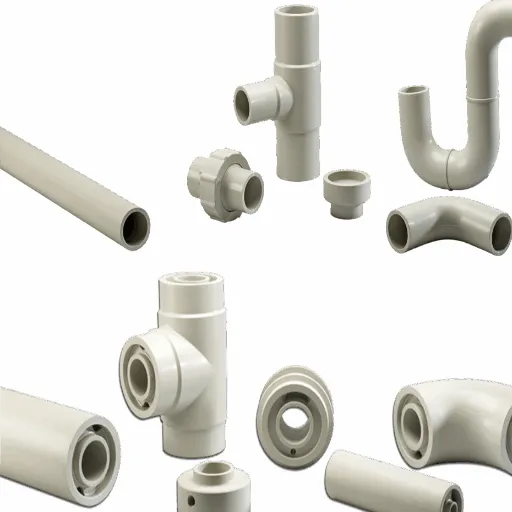
Advancements in Manufacturing Technologies
Inspiring, rewarding, breakthrough date applications to any given field of manufacturing technology include polymer technology for the production of polypropylene piping systems. Designers using CAD and computational models during the design phase optimize pipe systems for structural integrity and material efficiency. These systems allow the simulation of stress environments, thermal cycles, and flow rates with fine precision.
Subsequently, robotization and automation have had a dramatic impact on the production process by gaining better consistency and reducing errors in manufacturing. Automated control systems are entrusted with extrusion, welding, and quality inspection to ensure that products tightly adhere to industry standards while being economically consumptive of raw materials. There is rising fame for additive manufacturing methods such as 3D printing through rapid prototyping and innovation avenues to manufacture complex geometries that, to date, have been unattainable by traditional means.
Another important developed advancement is in advanced materials, such as reinforced polypropylene composites, which confer improved mechanical strength and chemical resistance. They allow applications in environments requiring high specification, such as those in corrosive chemical processing and high-pressure fluid transport. Meanwhile, machine-learning algorithms coupled with big data analytics are providing support for predictive maintenance, thus monitoring the health of equipment while predicting their potential sudden failures.
Pushed by improved manufacturing technologies, continual growth in efficiency and innovation exists, equipping industries with better tools to confront modern challenges. On the one hand, these developments lengthen system life and, on the other, keep up with environmental concerns, motivating sustainability through less material wastage as well as less energy consumption.
Eco-friendly Options in Polypropylene Fittings
Adoption of green measures in polypropylene fitting manufacture represents a defining step toward sustainability in industrial activities. Contemporary development uses recycled polypropylene materials, greatly shrinking the ecological footprint posed by manufacturing plastic in its raw form. Recycled polypropylene retains the mechanical prowess and chemical resistance required for use in plumbing, chemical processing, irrigation, and other such processes.
Furthermore, futuristic implementations become more interesting when viewed alongside bio-based polypropylene, as an alternative to the conventional petroleum-based kind, made with renewable sources like sugarcane or cornstarch. Thus, in terms of durability and usability, these bio-based counterparts are parallel to the traditionally manufactured polypropylene, while on their side, they help reduce the carbon footprint by employing renewable feedstocks.
On the other hand, from a different managerial perspective, the optimization of production by energy-efficient technologies stands out. Processes such as state-of-the-art injection molding and precision extrusion contribute further to reducing the energy consumption in production. These actions even extend their presence to the considerations of lifecycle assessment, with findings underpinning the reduction of emissions along a material’s lifecycle.
Lastly, we must admit that the industry standards increasingly tend to verify and require the environmental certifications, either GreenCircle Certified or EU REACH specifications, depending on the certification scheme, to guarantee further that polypropylene fittings meet stringent eco-conscious requirements. These certifications increase environmental transparency on their performance and offer extreme credibility to both manufacturers and consumers.
Therefore, it is expected that using green options in polypropylene fittings will reinforce industries’ support for circular economy concepts worldwide, while still maintaining their production efficiency and reliability.
Challenges in Compatibility and Maintenance
One of the most pressing challenges confronting compatibility and maintenance of polypropylene fittings is enabling their seamless integration with legacy systems and dissimilar material standards. Polypropylene, being such a very versatile material, may at times be incompatible with an already existing infrastructure constituted of metals or otherwise polymers-that is to say, given existing conditions, one must always exercise a thorough check of material compatibility. In joining techniques, heat fusion may require expensive and specialized equipment as well as skilled operators, thereby increasing operational complexity.
On maintenance, environmental issues are encountered: long-term ultraviolet exposures, for example, may cause degradation unless the polypropylene is properly stabilized with additives. The performance in the long term also depends on the chemical exposure, considering that some agents from the adversarial chemicals could seriously impair the strength of polypropylene. These will have to be taken into consideration along with periodic inspections as an attempt to guarantee the dependability and longevity of the fittings even under varied environmental conditions.
Another factor to consider is that the dimensional and pressure ratings may vary with regions or industries, which could result in incongruities between fittings from different suppliers. Hence, it is imperative to conduct detailed compatibility checks, adhering to international standards of ISO or ASTM, to avoid any kind of operational inconveniences. Confronting these challenges, hence, warrants continuous research, advanced material engineering, and immaculate quality-assurance programs to guarantee performance and reliability as well as ease of maintenance.
Selecting the Right Polypropylene Fittings
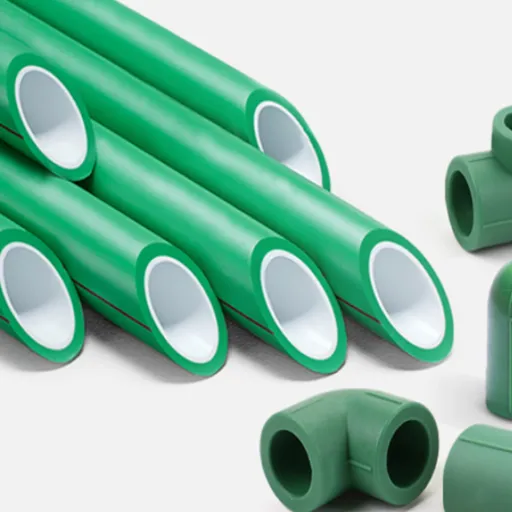
Factors to Consider for Your Project
When choosing polypropylene fittings for your specific application, a few crucial factors need to be considered to ensure maximum performance and longevity while respecting industry norms. These include:
🧪 Chemical Resistance
Polypropylene is generally considered very resistant to a broad class of chemicals, such as acids, bases, and organic solvents. However, it is equally vital to determine the specific chemicals to which your system may be exposed. You should consult the material datasheet or any chemical resistance chart to verify that polypropylene is, in fact, compatible with the intended media under operating conditions.
🌡️ Temperature and Pressure Ratings
Temperature and pressure during installation and operation act directly upon the performance characteristics of the polypropylene fittings. This material has earned some credits for durability, but its mechanical strength is greatly reduced at higher temperatures. Therefore, it is important to know the maximum temperature and pressure for your application, both amongst standards (ISO 15494) and specifications, and ensure that the fitting meets or exceeds those values.
🔧 Installation and Connection Types
Review the manner in which the fittings will be connected within the system. Threaded, socket-weld, and flanged may be possible options. All of these can offer some perks depending on system arrangement, view, and access to maintain it, and how tight the joint should be. Make sure that the installation method is according to the manufacturer’s instructions so that it can maintain the integrity of the joint.
🌍 Environment
Evaluate the environmental factors in which it is intended that the fittings operate. Things like UV exposure, humidity, or even threats of infringement might influence the behavior of the material. Certain polypropylene grades, such as UV-stabilized one,s may need to be considered for outdoor or severe environments to forestall early degradation.
📋 Compliance with Industry Standards
Fittings should be purchased from manufacturers that adhere to crucial standards such as ASTM D4101 for polypropylene materials or ISO 161 for plastic piping systems. This way, you get components of consistent quality that satisfy the safety requirements for varied uses.
💰 Economic Considerations
Lastly, weigh the cost-efficiency with long-term value. While generally considered to have a decent short-term profile for cost when compared to others, improper selection of polypropylene fittings results in a higher lifecycle cost due to failures, repairs, or even premature replacement. Make sure you do a careful cost-benefit analysis supported by the manufacturer’s data and projections for life expectancy.
A very careful study of these considerations will result in a scientifically designed and durable system, minimizing risk whilst growing performance in a harsh environment.
Recommendations for Professionals vs. DIY Enthusiasts
The best professional will use advanced interest, will install it perfectly, and will make it adequate to building standards, while the DIYers must concern themselves with simplicity and cheapness, plus use of the most basic tools.
| Key Point | Professionals | DIY Enthusiasts |
|---|---|---|
| Tools | Advanced, specialized | Basic, easy-to-use |
| Installation | Precise, standard-compliant | Simple, user-friendly |
| Cost | Higher upfront, durable | Budget-friendly |
| Skills | Expert-level required | Basic knowledge sufficient |
| Standards | Strict adherence | General guidelines |
| Time | Longer, detailed process | Quick, straightforward |
| Durability | Long-lasting, robust | Moderate, adequate |
| Flexibility | Customizable solutions | Pre-designed options |
Size and Pressure Considerations
Considerable emphasis is placed upon the operational requirements and constraints during the selection of the sizing and pressure of a system or component. My method involves determining first the range of pressure and volume that the system is anticipated to operate with under normal, peak, or emergency conditions. It is on this basis that one selects component facilities; thus, pipe, valve, tank, or whatever else that conforms to functional demand and has a safety margin built into it, permitting optimum system performance while minimizing potential for failure.
In sizing and pressure determination are the effects of fluid type, flow rate, and environmental conditions are considered as these variables impose different limits. Comprehending the behavior of compressible fluids like gases under pressure adjustments has to be distinct from the behavior of insoluble fluids like water. I have learned through experience that by undertaking with standardized calculation methods and simulation software, one can make great sizing recommendations, taking into account the branching complexity of parameters.
In my opinion, code and standard compliance is the key to check if size and pressure specifications satisfy regulatory and operational objectives; these codes and standards set benchmarks for such aspects as design, construction, inspection, and testing to ensure long-term performance and reliability under arduous working conditions. Efficiency combined with resiliency can only come from a methodical and well-detailed process of evaluation and selection, together with knowledge of materials’ strength and pressure ratings.
Frequently Asked Questions (FAQ)
Common Questions About Polypropylene Pipe Fittings
❓ What are polypropylene pipe fittings?
Polypropylene pipe fittings are plastic connectors widely applied in piping systems. Being highly chemical-resistant and rigid, they are the preferred choice where acids, fuels, and other harmful substances are being handled.
❓ What chemicals do polypropylene pipe fittings resist?
Polypropylene pipe fittings can resist a great variety of chemicals, including nitric acid, hydrochloric acid, ethanol, and sodium hypochlorite. It is equally suitable to convey gasoline, kerosene, or fertilizers that are acid-based.
❓ Are polypropylene pipe fittings manufactured in metric sizes?
Polypropylene pipe-fitters are manufactured in metric sizes to fit an extensive range of piping configurations. This installation possibility increases the integration efficiency with existing systems and other compatible components.
❓ How does one select the correct size of polypropylene pipe fittings?
The right size of polypropylene pipe fittings will be selected by measuring your pipe diameter and matching it against either standard or metric sizes. One must regularly refer to the fitting catalog for suitable choices.
❓ Can polypropylene pipe fittings be used in outdoor applications?
Polypropylene pipe fittings, being well resistant to UV light and the weather, are perfect for outdoor use. Depending on the type of liquid being handled, they serve as a perfect choice for agricultural or industrial purposes.
❓ What is the maximum pressure rating for polypropylene pipe fittings?
The maximum pressure rating for polypropylene pipe fittings usually depends on the product itself and how it is arranged. Many fittings can be subject to pressures of up to around 150 psi, but one should take note of the specifications concerning individual fittings for the exact pressure rating.
❓ Are polypropylene pipe fittings okay for heating systems?
Polypropylene pipe fittings are usually used in heating systems as they are suited for low-pressure applications. Many applications involve temperatures that exceed the operating range of polypropylene pipe fittings.
❓ How do polypropylene pipe fittings compare with metal fittings?
Polypropylene pipe fittings have several advantages over metal fittings, consisting of being lighter in weight, corrosion-free, and relatively less expensive. However, where applications involve very high temperatures or very high pressures, metal fittings are preferred to provide greater durability.
❓ Are polypropylene pipe fittings to be used for fuel applications?
Polypropylene pipe fittings are excellent for fuel applications involving the transfer of gasoline and kerosene. Their chemical resistance ensures that the fittings maintain their integrity and perform adequately while handling such substances.
❓ What types of fittings are there for polypropylene piping systems?
Among polypropylene piping systems, an assortment of fittings is available, ranging from elbows, tees, couplings, bushings, to plugs. Each type of fitting serves a particular purpose in the system, which enables the piping to be configured efficiently and flexibly.
References
- Feasibility Study for Establishing Polypropylene Random Copolymer (PPR) Pipes and Fittings Plant
The study evaluates the feasibility of producing PPR pipes and fittings and provides information regarding their use and production. - Plastic-Lined Piping for Corrosion Resistance
The handbook takes up the topic of using polypropylene as a liner for pipes and fittings with particular emphasis on corrosion resistance. - Testing of Recycled Polypropylene as a Viable Structural Material
This study focuses on the viability of recycled polypropylene in structural applications, including in piping systems. - Click here to read more.
Conclusion
Polypropylene pipe fittings represent a cornerstone of modern piping infrastructure, offering unmatched versatility, durability, and cost-effectiveness across diverse applications. From residential water systems to complex industrial chemical processing, these fittings continue to revolutionize how we approach fluid management. With ongoing innovations in manufacturing technology and environmental sustainability, polypropylene fittings are poised to play an even more critical role in future infrastructure development, making them an indispensable choice for engineers, contractors, and DIY enthusiasts alike.



